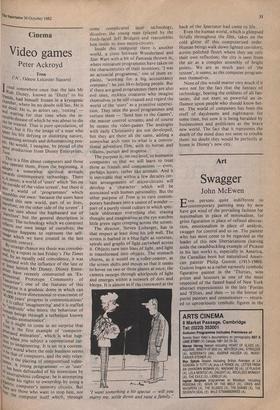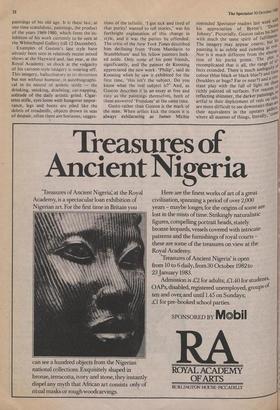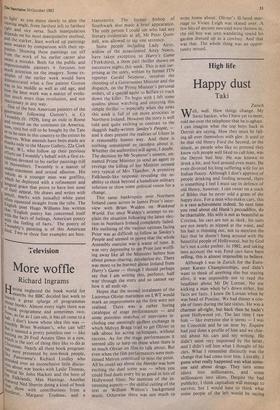Art
Swagger
John McEwen
Even persons quite indifferent to contemporary painting may by now have got wind of the prevailing fashion for maximalism in place of minimalism, for gross figuration in place of refined abstrac- tion, emotionalism in place of analysis, swagger for control and so on. The painter who has most come to be regarded as the leader of this new libertarianism (leaving aside the swashbuckling example of Picasso in his last work) is, especially in America, the Canadian born but naturalised Ameri- can painter Philip Guston (1913-1980). Guston began as a rather earnestly symbolic figurative painter in the 'Thirties, won prizes and honours as one of the most respected of the famed band of New York abstract expressionists in the late 'Forties and 'Fifties, and then — to the horror of purist painters and connoisseurs — return- ed to uproariously symbolic figures in the
paintings of his old age. It is these last, at one time scandalous, paintings, the product of the years 1969-1980, which form the ex- hibition of his work currently to be seen at the Whitechapel Gallery (till 12 December).
Examples of Guston's late style have already been seen in relatively recent mixed shows at the Hayward and, last year, at the Royal Academy, so shock at the vulgarity of his cartoon-style imagery is wearing off. This imagery, hallucinatory in its distortion but not without humour, is autobiographi- cal in its record of artistic strife — the drinking, smoking, doubting, cat-napping, solitude of the daily artistic grind. Cigar- ettes stifle, eyes loom with hungover impor- tance, legs and boots are piled like the debris of treadmills, objects drown in seas of despair, often there are horizons, sugges- tions of the infinite. 'I got sick and tired of that purity! wanted to tell stories,' was his forthright explanation of this change in style, and it was the purists he offended. The critic of the New York Times described him declining from 'From Mandarin to Stumblebum' and his fellow painters look- ed aside. Only some of his poet friends, significantly, and the painter de Kooning appreciated the new work. 'Philip', said de Kooning when he saw it exhibited for the first time, 'this isn't the subject. Do you know what the real subject is?' And, as Guston describes it in an essay as free and easy as the paintings themselves, both of them answered 'Freedom' at the same time.
Gusto rather than Guston is the mark of the man. When artists kick the traces it is always exhilarating as James Michie
reminded Spectator readers last week with his appreciation of Byron's `D°rIn) Johnny'. Pictorially, Guston takes his leave with much the same spirit of fulfillment- The imagery may appear coarse, but his i painting is as subtle and cunning as ever: Nor is it much different from the abs tion of his purist prime. The Pl°,t recomplicated that is all, the range 0' e„/ fects extended. There is much ambiguity colour (blue black or black blue?) and fora (boulders or bugs? Far or near?) and a stant play with the fall of light on thes',. richly painted oil surfaces. For reasons 01.. reflecting shimmer, the darker paintings,,su artful in their deployment of reds on re°se' are more difficult to see downstairs than ar, their equivalents in the upstairs galle,nr); where all manner of things, literally, e°''' kJ often squeezed straight from the tube. The i‘v,illeh he deployed with a refinement and 0f their appeal. He draws and writes with Pencil, marks with (usually) white paint d°r to be seen in this country to the extent he deserves. What amends have been made are Street, w , .efforts on Twombly's behalf with a first ex- hibition devoted to his earlier paintings (till under-statement and sexual allusion. His vehicle as a younger man was graffito, generation following Guston's is Cy Twornbly (b. 1929), long an exile in Rome and revered on the continent (in America, °°w, too) but still to be bought by the Tate Much attention on the imagery. Some ex- was in his middle as well as old age, and how the later work was a matter of evolu- tion much more than revolution, and not reactionary in any way. to light' as you move slowly to alter the right and vice versa. Such manipulation depends on his most manipulative method, and the starker, least worked up paintings seem weaker by comparison with their op- posites. Showing these paintings cut off seems a mistake. Both for the public and IMPressionable painters it forcuses too amples of the earlier work would have demonstrated what a fine painter Guston 16 November). Twombly is a master of viewing angle, from farthest left to farthest from the work of his earlier career also "quid grace that prove to have lost none tanks only to the Mayor Gallery, 22a Cork
One of the best American painters of the
who follow up their previous that 'English poetry has concerned itself .ith the facts of feelings, American poetry TWith the feeling of facts.' The poetry of k."InblYs painting is of this American Ind. Two or three fine examples are here.












































 Previous page
Previous page